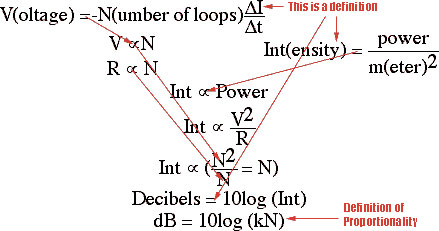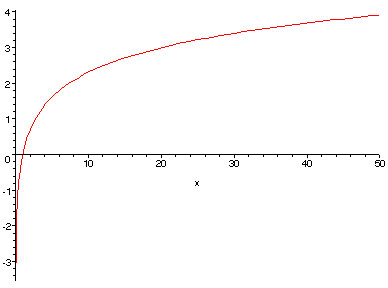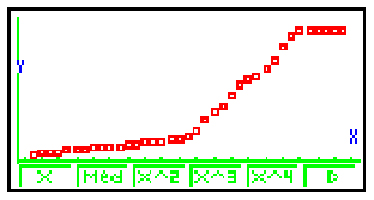It has been discovered that we perceive volume logarithmically with respect to sound intensity. This means that, to increase the volume of something by one Bel, the unit of audible sound (decibels are used more often; there are, of course, 10 decibels in a bel), the power of the sound signal must be multiplied by ten. As this guitar works directly with both sound and power, a knowledge of this fact affects several aspects of the guitar design.
First, this fact tells us that the number of loops in the pickup is also logarithmically related to the perceived volume. See the derivation below for a proof of this:

Derivation showing number of loops in pickup is logarithmically related to volume.
'k' in the last step of the derivation is a constant; its composition is based on the variables that are dropped earlier in the derivation by way of proportionality statements. If the 'k' were to be factored out of the expression, the final equation would read dB = 10log N + k2, where k2 = 10log k. This means that having 300 loops would lead to an approximate volume of 25 + k2 dB, whereas 700 loops would lead to 28 + k2 dB. In this case more than doubling the number of loops only increases the decibels by three; as a result, we can conclude that the exact number of loops, if in the hundreds, is relatively insignificant. That's why you don't have to worry about the loop count when you make the pickup.
Also, this means that, in order to get a nice, smooth transition in volume with a volume knob, the change in power going through the potentiometer must also be logarithmic. Here is a graph of power vs. volume for an ideal volume knob, as compared to a graph of the knob's resistance (which is related to power) versus its rotational position:

Power vs. volume, ideal graph.

Potentiometer graph.
As you can see, the right half of the potentiometer graph of resistance vs. position looks much like the ideal graph. I'm not entirely sure why they don't just make the whole range of the potentiometer like the ideal graph; I suspect it's because this is close enough. In any case, it's much better than a straight linear change in resistance.
